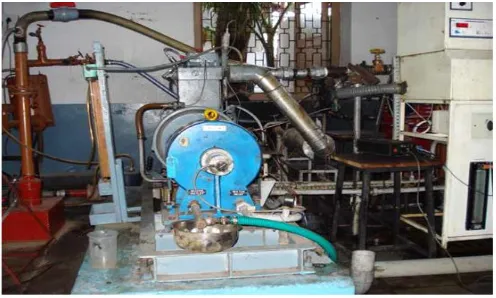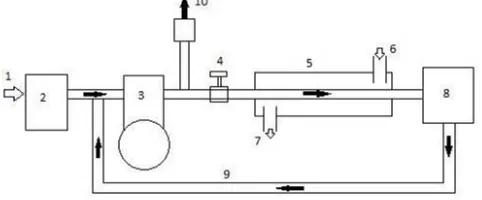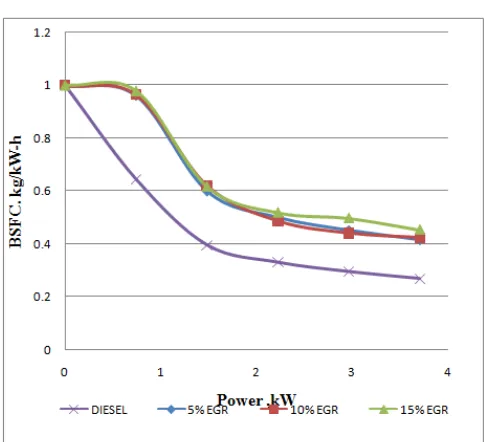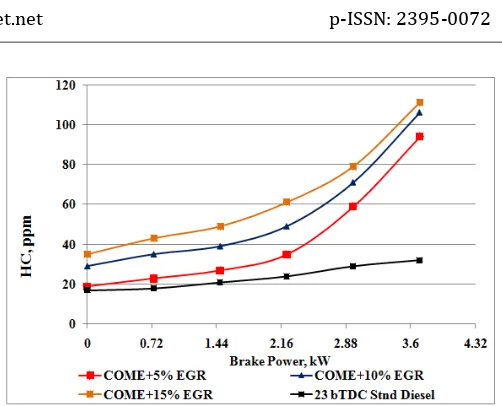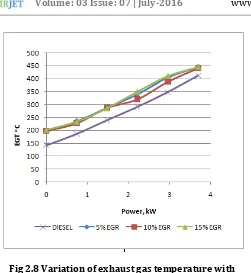© 2016, IRJET | Impact Factor value: 4.45 | ISO 9001:2008 Certified Journal
| Page 1288
EFFECT OF EXHAUST GAS RECIRCULATION ON PERFORMANCE AND
EMISSION CHARACTERISTICS OF DIESEL ENGINE WITH A COTTONSEED
OIL AS BIODIESEL
GOPAL PUJER, PROF C.N.NATARAJ
---***---Abstract
- In the present work, bio-diesel is prepared from cotton seed oil and blended with diesel. The fuel properties of the synthesized bio-diesel were determined and their performance, emission and combustion characteristics were studied on a four-stroke, single cylinder, to ensure their suitability as CI engine fuel three different EGR percent’s 5%,10% and 15% are used.After conduction of experiment and obtained results I came to know that there is a steady increase in brake thermal efficiency as load increases, for standard diesel at 23 BTDC and cottonseed oil blend at different EGR percent. This is due to poor mixture formation as a result of lower volatility, higher viscosity and density of the cottonseed oil. Brake specific fuel consumption decreases from higher to lower as the Brake power increases. At the higher brake power level the brake specific fuel consumption is lower for standard diesel as well as cottonseed oil.
The NOx emissions will reduce by increase in the EGR percentage that tends to reduce the adiabatic flame temperature and there by the combustion temperature, therefore, NOx concentration decreases as CI engine inlet air flow is diluted with exhaust gas at a constant fuel rate. HC emissions are comparatively higher for cottonseed oil blend. As the EGR percentage increases CO emission increases and CO2 emission decreases this is because oxygen supply is good and it reduces carbon dioxide but due to insufficient combustion carbon monoxide increases.
Key Words:Biodiesel, EGR, COME, NOX
1.
INTRODUCTION
Vitality is the life line of person leaving on the earth. Each division over the globe needs vitality, a vitality that can be renewed and more important is environmental friendly and that would not influence our environment and leaving things on the earth. Transportation is one of the areas that expend a greater amount of the vitality. These days because of the restricted assets of fossil energizes, rising unrefined petroleum prices and the increasing concerns for the
environment, there has been reestablished concentrate on the vegetable oils and creature fats as an option fuel sources. Vegetable oil fuels are not presently petroleum competitive energizes because they are more costly than petroleum fills. Nonetheless, with the recent increase in petroleum price and the uncertainties concerning petroleum accessibility, there is renewed interest in utilizing vegetable oils as a part of Diesel motors. Bio-diesel is the name for an assortment of ester-based oxygenated fuels got from common, renewable biological sources like vegetable oils. Bio-diesel works in compression ignition engines like petroleum diesel in this manner requiring no essential engine changes. Bio-diesel fuel can be produced using new or used vegetable oils and creature fats. Unlike fossil diesel, immaculate bio-diesel is biodegradable, non-toxic and essentially free of sulfur and aromatics.
The most predominantly used oil bearing crops as fuel substitutes are Sunflower, Soya bean, Cotton seed, winter Canola and Peanut. India has large waste land, which can be utilized to develop the biodiesel seed creating plants. There are number of plant species yielding oilseeds (non-consumable), which have great potential for making biodiesel and to be utilized as a fuel in conventional diesel motors with little or no modifications in basic engine outline. Biodiesel has demonstrated a lot of promise in terms of both its relatively higher combustion efficiency and lower harmful emissions. The emissions from biodiesel are diverse than petroleum-based diesel and it is important to see how they are different with respect to the levels emitted and the combustibility of the particulates. Studies conducted over the last decade have well established a direct relationship between deteriorating human health and diesel engine exhaust.
Numerous scientists have found that with biodiesel fueled motor produces higher NOx emission contrasted with
diesel. To achieve reductions in NOx emissions, exhaust gas
recirculation (EGR) can be utilized with biodiesel as a part of the diesel motors. EGR is an effective technique of decreasing NOx emissions from the diesel engine fumes. Controlling the
© 2016, IRJET | Impact Factor value: 4.45 | ISO 9001:2008 Certified Journal
| Page 1289
temperatures. However, the application of EGR results in higher fuel consumption and discharge penalties also EGR increases HC, CO, and PM emissions alongside slightly higher particular fuel consumption.
1.1 Comparison of properties of CSO, C20 and
Diesel
Properties of CSO, CS20 and diesel were carried out by different apparatus and observed that the properties of CSO is larger than the diesel and after esterification and blending with diesel the properties of C20 is getting nearer value of diesel that flash point and fire point were quite lesser than the diesel and oil is eligible for running the single cylinder diesel engine by the C20 oil.
1.2
Experimental set-up
The engine tests were conducted on a four-stroke, single-cylinder Diesel engine. The engine operated by varying injection pressure
Fig.1.2. Block diagram of experimental setup
1. Diesel engine 6. Shaft encoder
2. Alternator 7. Computer
3. Load cell 8. Exhaust gas analyzer
4. Fuel tank 9.ETM meter
5. Pressure pickup 10. Data acquisition system
1.3 Engine set up
The test engine used is a single cylinder four stroke diesel engine. It produces 83.7 kW of rate power at 1500rpm with a compression ratio of 17.5:1. The engine is cooled using the water. The engine is started by hand cranking. Detailed specification of test engine is listed below in Table.
[image:2.595.38.283.231.350.2]Fig shows the block diagram for engine test rig, computer was used to note down the various parameters from the experiment. The experiments are carried out at the rated speed of 1500 rpm at different load conditions. The eddy current dynamometer is used to vary the load by applying the load. Engine is first operated by the diesel oil for the heating purpose and then the different blends of fuels are used to run the engine. Rate of flow of fuels will be noted by the burette and cylinder pressure is controlled by the control panel. Exhaust gas temperature will be noted by the temperature sensors. Exhaust gas analyzers were switched on and allowed to stability before measurements.
Fig.1.3 Engine Experimental set up
1.4 Engine Specifications
[image:2.595.311.559.370.519.2]© 2016, IRJET | Impact Factor value: 4.45 | ISO 9001:2008 Certified Journal
| Page 1290
Exhaust Gas Recirculation is a useful technique for reducing nitrogen oxides formation in the combustion chamber of C.I. engines. Fig 1.5 shows the arrangement of exhaust gas recirculation (EGR) system. The principle of EGR is to recirculate about 10% to 30% of the exhaust gases back into the inlet manifold where it mixes with the fresh air and this will reduces the quantity of O2 available for combustion.
This reduces the O2 concentration and dilutes the intake
charge, and reduces the peak combustion temperature inside the combustion chamber which will simultaneously reduce the NOx formation. It should be noted that most of the NOx
[image:3.595.316.559.88.264.2]emission occurs during lean mixture limits when exhaust gas recirculation is least effective. The exhaust gas which is sent into the combustion chamber has to be cooled so that the volumetric efficiency of the engine can be increased. EGR ratio is defined as the ratio of mass of recycled gases to the mass of engine intake. EGR is the most efficient and widely used system to control the formation of oxides of nitrogen inside the combustion chamber of IC engine. The exhaust gas for recirculation is taken through an orifice and passed through control valves for regulation of the quantity of recirculation.
Fig.1.5 Block diagram of exhaust gas recirculation
1. Air inlet 2. Inlet air orifice box
3. Test engine 4. EGR control valve
5. Heat exchanger 6. Water inlet
7. Water outlet 8.EGR orifice meter
9. EGR pipe 10.Exhaust gas outlet
[image:3.595.46.287.370.470.2]The EGR gas is cooled by the heat exchanger to introduce a greater amount of re circulated gas. The silica gel container is used to absorb the carbon particles comes out through the exhaust gas. EGR valve controls the gas percentage which will be re-introduced to the engine inlet manifold.
Fig 1.5 Set up of Exhaust Gas Recirculation System
1.6 Engine tests
Engine performance is an indication of the degree of success with which it is doing it assigned job that is the conversion of the chemical energy contained in the fuel into the usefull mechanical work. The degree of success is compared on the basis of the following tests.
1. Break thermal efficiency
2. Brake mean effective pressure
3. Brake specific fuel consumption
4. Exhaust emissions
Specific fuel consumption is widely used to compare the performance of different engine. Mean effective pressure, gives an indication of engine displacement utilization Higher the mean effective pressure higher will be power developed by the engine for a given displacement. Brake thermal efficiency is the true indication of the efficiency with which thethermodynamic is converted into mechanical work. It also accounts for combustion efficiency. Exhaust emissions such as unburned hydrocarbons, carbon dioxide etc are nuisance for the public environment. The exhaust gas percentage is varied at differentiates as 5%, 10% and 15% and the above engine test are calculated.
2.
RESULTS AND DISCUSSIONS
© 2016, IRJET | Impact Factor value: 4.45 | ISO 9001:2008 Certified Journal
| Page 1291
fuel consumption is lower for standard diesel as well as cottonseed oil.
The NOx emissions will reduce by increase in the
EGR percentage that tends to reduce the adiabatic flame temperature and there by the combustion temperature, therefore, NOx concentration decreases as CI engine1inlet air
flow is diluted with exhaust gas at a constant fuel rate. HC emissions are comparatively higher for cottonseed oil blend. With the 10% EGR induction, the combustion degradation lowers the temperature. The decreased air fuel ratio associated with EGR induction and reduced combustion temperature results in incomplete fuel combustion.
Smoke emission was higher for the cottonseed oil blend than for standard diesel operation. This may be due to the heavier molecular structure, higher viscosity of the cottonseed oil. The smoke capacity for cottonseed oil was even higher with 10% EGR induction. This negative effect of EGR on smoke opacity could be due to the reduction of the engine air-fuel ratio
.
2.1 Performance parameters curves
Fig 2.1 Variation of brake thermal efficiency with brake power
[image:4.595.312.557.95.316.2]From the Fig 2.1 it shows that there is a steady increase in brake thermal efficiency as load increases, for standard diesel at 23 BTDC and cottonseed oil blend at different EGR percent. It was observed that the brake thermal efficiency of the engine was lower for the entire load range for cottonseed oil blend as compared to diesel operation. This is due to poor mixture formation as a result of lower volatility, higher viscosity and density of the cottonseed oil and also the implementation of EGR.
Fig 2.2 Variation of BSFC with brake power
Fig 2.2 shows the variation of brake specific fuel consumption with brake power for standard diesel and cottonseed oil blend at 5%,10%,15% EGR. The brake specific fuel consumption is defined as the ratio rate of fuel consumption to the rate of power production. Brake specific fuel consumption decreases from higher to lower as the Brake power increases. At the higher brake power level the brake specific fuel consumption is lower for standard diesel as well as cottonseed oil blend at different EGR percentages.
[image:4.595.41.285.368.523.2]2.2 Emission and exhaust temperature
characteristics curves
Fig 2.3 Variation of NOx emission with brake power
Fig 2.3 shows the variation of NOx v/s brake power, as brake
power increases the NOx emissions gradually increases. The
lowest emissions of NOx were obtained with cottonseed oil
used in the EGR system engine with 15% EGR induction. The NOx emissions will reduce by increase in the EGR percentage
[image:4.595.310.555.499.647.2]© 2016, IRJET | Impact Factor value: 4.45 | ISO 9001:2008 Certified Journal
| Page 1292
emissions are reduced. Therefore, NOx concentration
[image:5.595.308.559.62.265.2]decreases as CI engine1inlet air flow is diluted with exhaust gas at a constant fuel rate.
[image:5.595.41.282.143.301.2]Fig 2.4 Variation of Carbon monoxide v/s Brake power
Fig 2.4 shows the effect of brake power on CO emissions. CO emissions for diesel oil are comparatively low for standard engine operation than cotton seed oil blend. For the low heat rejection operation with cottonseed oil, 10% EGR induction dilutes the combusting mixture. Therefore, insufficient oxygen is available for better combustion and the lower combustion temperature present in the engine cylinder leads to comparatively higher CO emissions. The CO at 15% EGR percentage is higher as compared to pure diesel blends without EGR.
Fig 2.5 Variation of CO2emissions with different EGR
percent
Fig 2.5 shows the effect of brake power on CO2. CO2
emissions for diesel oil are comparatively low for standard engine operation than cotton seed oil blends. With the 10% EGR induction, the CO2 emission decreases this is
because the oxygen supply for combustion process is increases with the increase in EGR percents. Therefore complete combustion takes place, thus reduces CO2
emission.
[image:5.595.311.557.402.561.2]Fig 2.6 Variation of HC emission with brake power
Fig 2.6 shows the effect of brake power on HC emission and it can be observed that HC emissions are comparatively higher for cottonseed oil blend. With the 10% EGR induction, the combustion degradation lowers the temperature. The decreased air fuel ratio associated with EGR induction and reduced combustion temperature results in incomplete fuel combustion. These factors may lead to the higher HC emissions.
Fig 2.7 Variation of smoke capacity with brake power
[image:5.595.41.283.466.622.2]© 2016, IRJET | Impact Factor value: 4.45 | ISO 9001:2008 Certified Journal
| Page 1293
Fig 2.8 Variation of exhaust gas temperature with brake power
The exhaust gas temperature increases with increase in power. EGT increased with an increase in brake power for all fuel and engine conditions. The lowest values of EGT were obtained with standard diesel only engine operation and the highest values were observed for cottonseed oil under low heat rejection engine operation.
3.
CONCLUSIONS AND SCOPE FOR
FUTURE
a) Biodiesel is an oxygenated fuel that undergoes improved combustion in the engine due to the presence of molecular oxygen but leads to higher NOx emissions.
b) In the experiment higher NOx emissions is effectively controlled by 10% exhaust gas recirculation. Recycled exhaust gas lowers the oxygen concentration in the combustion chamber and increases the specific heat of intake charge which results in lower flame temperature and reduction in NOx formation.
c) Brake thermal efficiency of biodiesel is found to be comparable with diesel at all loads. The present experimental analysis on a single cylinder diesel engine with diesel and biodiesel blend at10% EGR has proved minimized pollution and improved performance. There is an average reduction of 40% NOx emission is obtained by 10% EGR.
d) Brake specific fuel consumption decreases from higher to lower as the Brake power increases. At the higher brake power level the brake specific fuel consumption is lower for standard diesel as well as cottonseed oil blend at different EGR percentages.
e) The CO at 15% EGR percentage is higher as compared to pure diesel blends without EGR. f) NOx emissions will reduce by increase in the EGR
percentage that tends to reduce the adiabatic flame temperature and there by the combustion temperature and hence NOx emissions are reduced.
Therefore, NOx concentration decreases as CI
engine1inlet air flow is diluted with exhaust gas at a constant fuel rate.
g) With the 10% EGR induction, the combustion degradation lowers the temperature. The decreased air-fuel ratio associated with EGR induction and reduced combustion temperature results in incomplete fuel combustion. These factors may lead to the higher HC emissions.
h) The smoke capacity for cottonseed oil was even higher with 10% EGR induction. This negative effect of EGR on smoke capacity could be due to the reduction of the engine air-fuel ratio.
i) The lowest values of EGT were obtained with standard diesel-only engine operation and the highest values were observed for cottonseed oil under low heat rejection engine operation. j) The NOx and CO emission is very high than any
blends .Among the different EGR, EGR with 10% has a moderate NOx and CO emission. Thus the overall comparison shows that EGR 10% with blend 20% yields the optimum value, with less fuel consumption and higher efficiencies than diesel and it is feasible us it in the diesel engine with no modification.
3.1 SCOPE FOR FUTURE
Though many advantages of EGR, still there are some limitations which can be resolved by further modification in future. In future long term assessment of engine durability and effect on lubricating oil of bio-diesel fueled engine with EGR need to be examined. Another field of research is development of sophisticated EGR valve which could response to dynamic mode of engine operation.
REFERENCES
1) “Experimental Investigation of a Diesel-Biodiesel Fuelled Compression Ignition Engine with Exhaust Gas Recirculation (EGR)”, Achuthanunni V, Baiju B, ISSN: 2249 – 8958, Volume-4 Issue-1, October 201Volume-4
2) “The performance and emissions of a variable compression ratio diesel engine fuelled with bio-diesel from cotton seed oil”R. Anand, G. R. Kannan, K. Rajasekhar Reddyand S. Velmathi, vol. 4, no. 9, november 2009 issn 1819-6608
© 2016, IRJET | Impact Factor value: 4.45 | ISO 9001:2008 Certified Journal
| Page 1294
Senthilkumar, Volume 3, Number 4, December 2009 ISSN 1995-6665 Pages 306 – 311
4) “Experimental studies on emission and performance characteristics in diesel engine using biodiesel blends and EGR (Exhaust Gas Resirculation)”, Pooja Ghodasara, Mayur Ghodasara,ISSN 2250-2459, Volume 2, Issue 2, February 2012
5) “Experimental Investigation of the Effect of Exhaust Gas Recirculation on Performance and Emissions Characteristics of a Diesel Engine Fueled with Biodiesel”, A. Paykani, A. Akbarzadeh and M. T. Shervani Tabar, Vol.3, No.3, June 2011 6) “Performance Analysis of Cottonseed Oil Methyl Ester for Compression Ignition Engines” Bhojraj N. Kale1, Dr.S.V.Prayagi,ISSN 2250-2459, Volume 2, Issue 8, August 2012
7) “Experimental Investigation On Performance, Combustion Characteristics Of Diesel Engine By Using Cotton Seed Oil”, S.KIRANKUMAR,IJETT, Volume 5 number 1 - Nov 2013 8) “Comparision of Diesel Engine Performance and Emissions from Neat and Transesterified Cotton Seed Oil”, A. Siva Kumar, D. Maheswar, K. Vijaya Kumar Reddy, Volume 3, Number 3, September 2009,ISSN 1995-6665 Pages 190 – 197
9) “Experimental Investigation of Cotton Seed Oil and Neem Methyl Esters as Biodiesel on CI Engine”, K.Dilip Kumar, P.Ravindra Kumar, Vol.2, Issue.4, July-Aug 2012 pp-1741-1746 ISSN: 2249-6645
